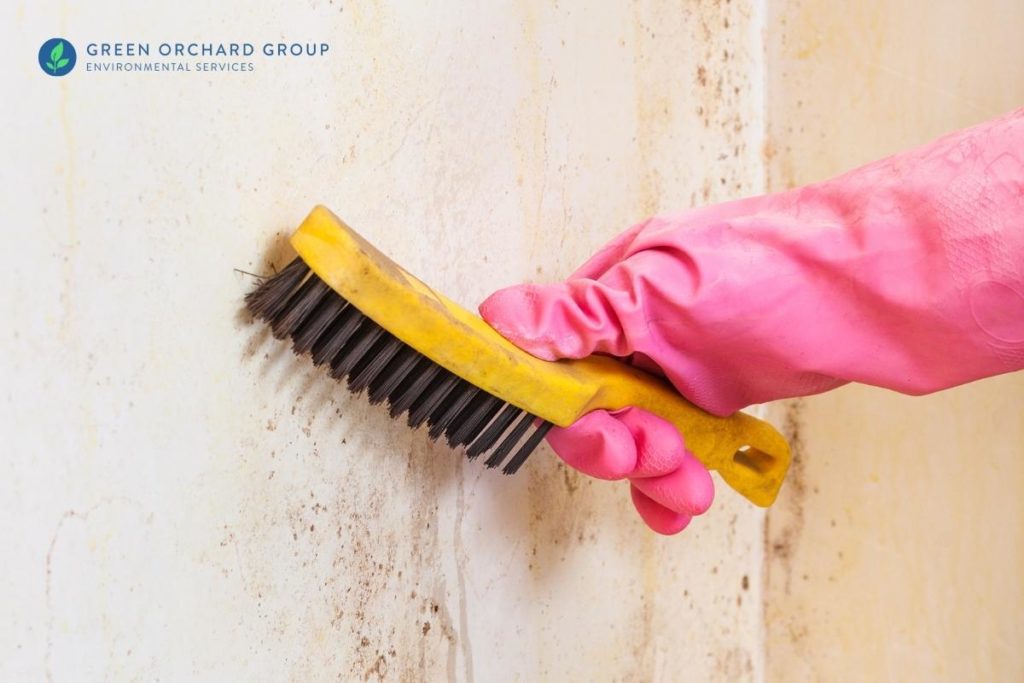
Mold on wood can cause unsightly stains, strange odors, and respiratory symptoms related to allergies or asthma.
In this article, we’ll explain when DIY mold removal is appropriate and how to remove mold from wood safely.
Based on our experience as licensed mold experts, there are certain cases where you can remove mold from wood yourself, but other times you’ll need professional help. When mold growth is severe, the underlying wood may have to be removed and discarded.
Can You Remove Mold from Wood?
Removing mold from wood isn’t as simple as wiping it off of linoleum floors or bathroom tiles. That’s because wood is a “porous” surface, meaning that it contains tiny microscopic holes or crevices that allow liquids — and mold — to penetrate underneath the surface.
There are 2 main factors that determine whether or not you can remove mold from wood yourself:
- How big is the surface area of wood affected by mold?
- How long was the wood left wet or damp?
According to the EPA: “if the mold area is less than about 10 square feet (less than roughly a 3 ft. by 3 ft. patch), in most cases, you can handle the job yourself.”
If you’re looking at mild mold damage covering an area smaller than 10 square feet, you can follow the steps in the next section to clean it up.
The other factor to consider is the amount of time the wooden surface(s) was wet or damp. Mold starts to grow within 24 to 48 hours after a wooden surface or object is exposed to moisture — especially after a water leak or flood. That’s why it’s important to fix the moisture problem and thoroughly dry the affected surfaces as soon as possible.
If the wood has been wet or damp for less than 48 hours, it can generally be cleaned and disinfected of mold.
But if it’s been wet for longer than 48 hours or there’s already a significant amount of visible mold growth present, then the wood should be removed and discarded using safe work practices.
How to Remove Mold from Wood (8 Steps)

Be careful when doing any kind of mold cleaning and removal. The process can cause a large amount of mold spores, toxins, or debris to be released into the air, which can be harmful if inhaled.
For mold damage that covers a large area or has been growing for longer than 48 hours, we recommend using a professional mold remediation service.
For mild to moderate mold damage covering a small area, follow these 7 steps to remove mold from wood:
- Wear protective equipment: rubber gloves, eye goggles, and N-95 mask
- Open windows or use fans to move contaminated air outside. Close interior doors or use plastic sheeting to seal off the work area and prevent mold spores and debris from spreading into other living areas.
- Use a vacuum with a HEPA filter to remove any loose mold spores and debris.
- Scrub the moldy wood with a mixture of hot water and soap or dish detergent.
- Disinfect the surface with a 10% bleach solution (mix 1 cup of bleach with 1 gallon of water). Never mix bleach with ammonia-based detergents, which produces toxic fumes.
- Let the bleach solution soak into the wood for at least 10 to 15 minutes.
- Rinse the wood with clean water and dry it thoroughly using towels, fans, dehumidifiers, or a wet/dry shop vacuum.
If there are still signs of visible mold on the wooden surface, then it might require professional methods to remove.
If the mold has already penetrated deep into the wood, then it should be discarded. For walls, floors, and ceilings, the mold-damaged area may need to be cut out and replaced.
Differences between Mold and Mildew on Wood
Mold and mildew are very similar (as we covered in another article), but removing mildew from wood is much easier than removing mold.
According to the National Institute of Environmental Health Sciences: “mildew is typically powdery and lives on surfaces, whereas mold tends to be fuzzy, thicker, and greenish or black in color.”
Mildew
- Usually starts off white or grey in color, but can later turn into a darker shade.
- Appears as thin layers of powdery or fluffy patches on smooth surfaces.
- Can easily be scrubbed off with soapy water or vinegar.
Mold
- Can be any color, but the most common ones are green or black.
- Appears fuzzy, slimy, and thick.
- Severe mold growth has a noticeably stale, musty odor.
- Penetrates into porous surfaces (like wood), so removing mold is more difficult.
A simple test you can do at home to check if you’re dealing with mold or mildew is to apply a few drops of a diluted bleach solution onto the affected area.
- After a few minutes, if it lightens up or disappears, then it’s likely to be mildew. You should be able to scrub it off relatively easily with warm, soapy water.
- If it remains dark or unchanged, then it’s likely to be mold. In that case, follow the steps above and contact a professional if necessary.
About Green Orchard Group
Green Orchard Group is a leading environmental health and safety services firm in New York City. We have a team of licensed mold assessment and remediation professionals with over 25 years of experience. If you need help inspecting or removing mold from your home or property, we are here to help!
Contact us today by calling (212) 219-8261 or filling out our contact form.
